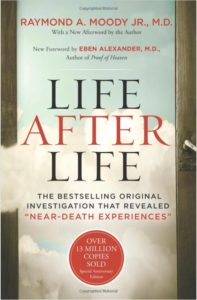Life After Life

Dr. Raymond Moody’s early training was in philosophy and in medicine. It was while undergoing psychiatric training at a hospital that he began hearing stories from patients about what he would later coin as “near death experiences”. After a few years, he gathered the stories together and wrote this book in 1975.
This book is a great introduction to the idea of life after death. It’s ideal for someone who has never heard of the possibility or who has never spent much time thinking of what life after death might actually entail. In fact, I loaned this book to a coworker who matches this description. I didn’t know it at the time, but she was struggling with the recent death of her father. She thanked me later and told me that it changed her attitude towards death and that she felt better about the situation.
The strength of this book lies in two things. First, in all the various first-hand accounts given by the many different people interviewed by the author. And second, in his ability to weave them all together into one generalized narrative to describe the transition into the afterlife. They are remarkable stories, one after another, of people who suffered some traumatic injury, illness, or accident and were declared clinically dead only to come back to life sometime later (minutes, usually). During that interval, their first experience is usually to find themselves invisibly and undetectably standing beside their physical body and the physicians, family members, and friends who had gathered there in support. They find themselves to be more aware and conscious than they were when “alive” and go on to describe several other key events that take place after that.
What impacted me the most was that just about every person interviewed stated that once they were out of their body and on their way to the next phase of existence, they were joyful and elated and did not want to return to their physical lives. One of the people interviewed remarks that when she found herself in that state, she said to herself, “Oh! I’m dead! How lovely!”
The author is honest throughout, always reiterating that none of this formulates an actual scientific proof of the afterlife. He is also not trying to disprove the theory that death is an “annihilation”. He is simply presenting case studies for the reader’s consideration.
There is an interesting chapter entitled “Parallels.” In it, Dr. Moody shows how accounts given directly to him from average, everyday people aligned quite well with passages from the Bible, from Plato’s dialogs, and from the more obscure Swedenborg, Tibetan Book of the Dead, or more esoteric classical yoga. None of the subjects had ever even heard of the latter three. This demonstrated that these sorts of experiences have been documented in various parts of the world in different times in history. In other words, these sorts of experiences occur across all continents, cultures, faiths, and epochs.
“Life After Life” is a quick read and a real eye opener. Its authentic and sincere tone make the facts presented completely neutral and unbiased. It’s the perfect way for someone to consider the real possibility of disembodied existence without any need to accept a religious doctrine, bias, or cultural viewpoint.
Copyright © 2024, SubtleRealm
